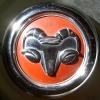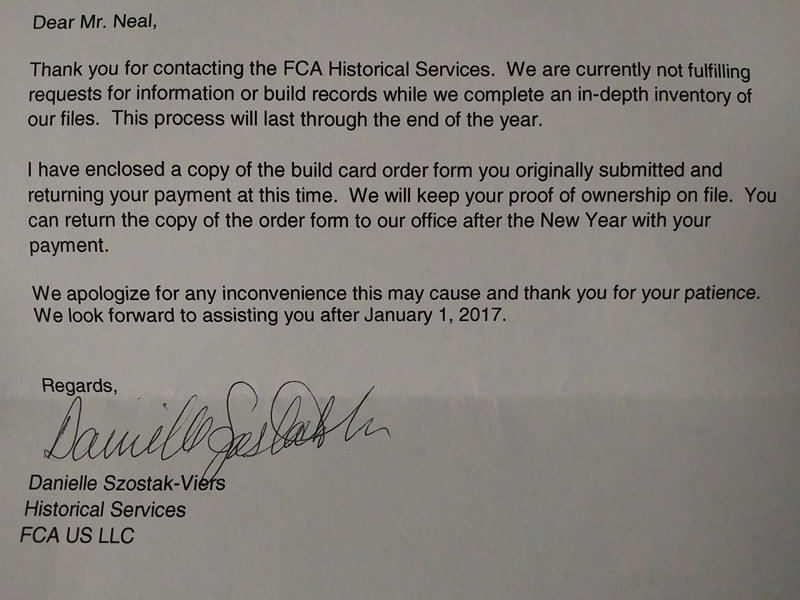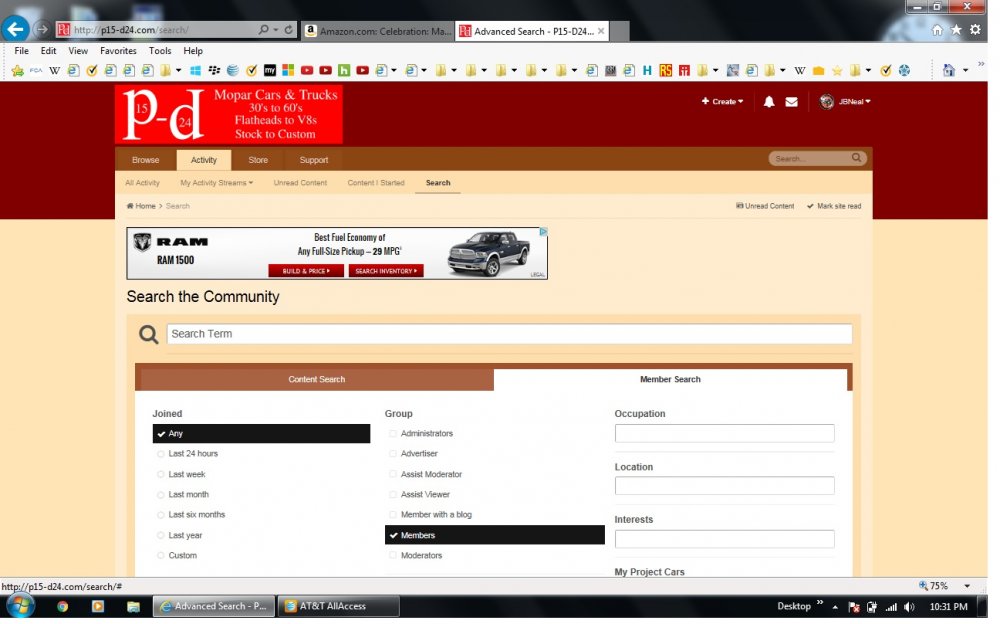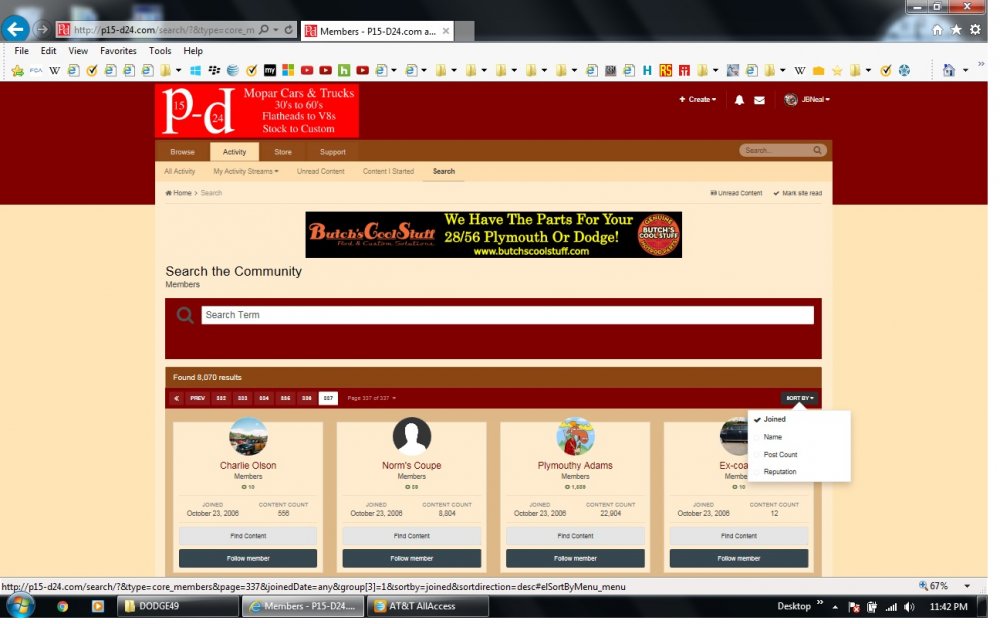-
Posts
7,180 -
Joined
-
Last visited
-
Days Won
79
Content Type
Links Directory
Profiles
Articles
Forums
Downloads
Store
Gallery
Blogs
Events
Everything posted by JBNeal
-
TOOLBOX ARSENAL: I was given this case of tools years ago and only recently took a closer look at it...manufacturing date of March 1959 was seen in several places, newest documentation appears to be from mid 60s, I'm thinking the batteries I removed from each of these are 50 yrs old and not leaking (which was clearly guaranteed on 2 of those batteries)...am looking forward to using these on the engine test stand
-

Best Differential Gear Ratios and Why?
JBNeal replied to 55 Fargo's topic in Mopar Flathead Truck Forum
Gearing really depends on the engine's output...I had a '92 Dakota with the Magnum V6 5spd and a 3.23 rear axle, and the truck did fine all around and got over 21 mpg on the highway, running right around 2000 rpm...I swapped in a 3.55 Sure Grip, and the truck had a different character: acceleration from stops was much faster, it seemed to pull better and had good passing power but seemed to run out of zip when ya got over 67 mph, fuel economy topped out at 20 mpg, running right around 2300 rpm, but it seemed more fun to drive because the engine seemed like it had more torque available at lower speeds. So for that engine, 3.23 was good for cruising, 3.55 was good for hauling. The flatheads are no different in that their relatively low horsepower and torque peaks under 2000 rpm so they do not benefit much from high revving like modern engines. That's why these old beasts can pull decent with the tall gearing...I've had well over 2000# in the back of my 1ton, and that stock 230 with the 4.10 axle can get rolling no problem from a stop, but I don't get in too big of a hurry because I do not think those brakes are too effective at higher speeds. I think the general consensus is that the flatheads can travel modern highways with the 3.73 and the 3.55, but the 3.73 pulls hills better than the 3.55. The 4.10 axles that I am running on the 1/2 ton and 1ton do well on the mostly rural back roads that I travel, where topping 50 mph is usually done rolling down hill with a tail wind -

Fuel Additives to counteract modern fuel additives
JBNeal replied to Tubeviper's topic in Mopar Flathead Truck Forum
Not wanting to stir up the oil debate again, but the cheap oil in the USA is light years ahead in formulations than the straight weight oil that was available back in the 50s...so proper maintenance with a cheap oil and a quality filter nowadays should yield a long lasting engine...Marvel Mystery Oil in the crankcase does wonders for the engine innerds, and the MMO in the tank, from my experience, has a tendency to stabilize ethanol treated gasolines so that it takes them longer to foul, as well as decrease starting times -
File this one under "gee thanks for updating your website"... this is why I have trouble getting excited about things nowadays
-
Roberts Steele Clester's Bernbaum's VPW additional info
-

Fuel Additives to counteract modern fuel additives
JBNeal replied to Tubeviper's topic in Mopar Flathead Truck Forum
Marvel Mystery Oil does great things -

Fuel Additives to counteract modern fuel additives
JBNeal replied to Tubeviper's topic in Mopar Flathead Truck Forum
I bought several NOS rubber fuel hoses that install between the steel fuel line and the fuel pump...the ethanol in gasoline nowadays causes that rubber to break down, so those NOS rubber lines are quite useless other than to be cautionary tales. The original fuel pump diaphragm will dry out fast, crack and fail when exposed to the ethanol additives in modern gasoline, but modern fuel pump rebuild kits include a diaphragm that is not prone to this type of early failure...the kit I installed in '04 on the 1-ton is still working, with that diaphragm observed recently to have a few small cracks probably due to age. I have had several knuckle draggers point out that I should be adding lead to my gas when I have filled up in the past, and when I ask which old buggy do they drive, they would proudly thump their chest with a Ford or Chevy response, to which I would smile and quietly chuckle...when they would bow up with their "how dare you besmirch my ride" response of "what do ya mean by that??" , I would point out that the Chrysler flatheads were designed to take a pounding, which would be met with a look of confusion and them fellas wandering away -
1/2, 3/4 and 1-ton steering wheels are all the same size...B-1 & B-2 steering wheels differ from B-3 & B-4 steering wheels in spoke layout and grip detail, but their hubs are all the same
-

How Many Pilot House Trucks Have Survived?
JBNeal replied to Bradley S.'s topic in Mopar Flathead Truck Forum
SURVIVOR: not a Pilot-House, but... Available at CTC Auto Ranch north of Denton -
VINTAGEPIC: saw this B-3or4 car hauler smashed on the FB...it appears the ram hood ornament stuck to the front of the truck was from a car
-

Much cooler than my first drive. What was yours?
JBNeal replied to Mr.Dids's topic in Mopar Flathead Truck Forum
First drive in a truck was when I was 11, took the '75 D200 Club Cab long bed five miles to pick up my dad at my grandparents' house (by myself)...I had been driving tractors for a couple of years at that point, no traffic on them country roads back then...almost drove to the high school for the first day of driver's ed 4 yrs later, but my ride finally showed up -

Welcome to the updated P15-D24.com SIte!
JBNeal replied to adminstrator_p15d24ph's topic in Forum Announcements And Feedback
after ya make the attached screen show up, scroll down and click the Search Members button on the lower right to see the members list...if you want to look at just moderators, check that box only, etc. -

Welcome to the updated P15-D24.com SIte!
JBNeal replied to adminstrator_p15d24ph's topic in Forum Announcements And Feedback
Go to the Activity tab and take a gander...this is the view from my pc; the view from my tablet is slightly different, showing a single column of member profiles as opposed to rows of profiles -
-

Dolly Dodge Needs New Wiper Blades & Heater update
JBNeal replied to DollyDodge's topic in Mopar Flathead Truck Forum
Might I suggest ya smear a little grease on the cab vent handle lock, ya know to keep things sophisticated -

Mopar Factory PCV System
JBNeal reviewed adminstrator_p15d24ph's file in Instructions, Manuals & Templates
-

What do 52 oe style tail lights look like?
JBNeal replied to jpartington's topic in Mopar Flathead Truck Forum
NOS taillight lenses NOS taillight housing NOS taillight bezel driver side taillight bracket driver side taillight bracket assembly passenger side taillight bracket assembly -
Builds Post revised and updated with Chrysler Master Tech - Story of Valves
-

What do 52 oe style tail lights look like?
JBNeal replied to jpartington's topic in Mopar Flathead Truck Forum
Driver side standard, passenger side optional...the originals are not very bright, upgrading to something that might look era-appropriate may get the uninsured motorists attention long enough to keep them from plowing into ya -

Original equipment/operation questions
JBNeal replied to Mr.Dids's topic in Mopar Flathead Truck Forum
Modern cars are regulated by FMVSS for uniform operation; before they were enacted, car companies followed some SAE standards but ultimately did whatever they wanted. The logic was that the parking lights were used when the vehicle was parked, the headlights were used when the vehicle was in motion, so both were not needed simultaneously. The tailgate reflectors were not a factory option, but many truck owners added them. There were simple flat reflectors available, and then there were the fancy jewel reflectors that many hot rodders covet. As far as optional equipment, the arm rests and sun visors could be ordered in cab package trim upgrades, the interior and passenger rearview mirrors and taillight were optional, and if you wanted turn signals, a heater and a radio, these were dealer installed options that had equivalent kits available at places like Western Auto, Sears and Roebuck and Montgomery Wards- 3 replies
-
- 3
-

-
- lights
- tailgate reflector
-
(and 1 more)
Tagged with:
-
additional information - Chrysler Master Tech - Story of Valves this vid echoes lots of information passed on by other members...very informative
-
have ya considered doing a conversion to AM/FM radio with MP3 jack or Bluetooth capability? There's a whole mess of outfits that can convert your tube type AM radio to a solid state device with modern features so that ya have the look of your original radio but with increased functionality
-
How'bout Big Frank, since it's a dually
-
I was stewing on the popping exhaust and kinda wondered if some of the valve springs were worn too...there's detail in the shop manual about using a special tool to check spring "strength" to determine if any require replacement. I suppose a weak spring will not keep the valve closed and could be the cause of a vacuum leak during operation, but I will have to yield to the experts on this one as book lurnin' cannot exceed field experience when addressing operation issues with the ignition system, valvetrain and carburetion
-
I'm kinda wondering if worn valve guides may be the cause of the not-so-smooth exhaust...if the valves are rattling around a little, they may get hung up before that instant that they need to closed...also, I recall that the engine idle speed should be closer to 450-500 rpm...I do not recall where I read it, but there is a way to replace worn valve guides with the engine in the truck. It involves a valve guide installation tool, a hammer, a cold chisel, and a lot of patience...I was able to replace the guides on the '49 while the engine block was in the truck, and if I over drove the guides, then I could carefully use a long pry bar to adjust the guide height







